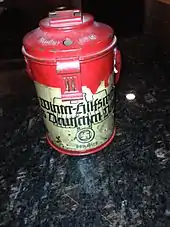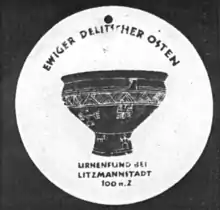Winterhilfswerk
The Winterhilfswerk des Deutschen Volkes (English: Winter Relief of the German People), commonly known by its abbreviated form Winterhilfswerk (WHW), was an annual drive by the National Socialist People's Welfare (German: Nationalsozialistische Volkswohlfahrt) to help finance charitable work. Its slogan was "None shall starve or freeze". The drive was originally set up under the government of Heinrich Brüning in 1931, though Adolf Hitler would later claim sole credit.[1] It ran from 1933 to 1945 during the months of October through March and was designed to provide food, clothing, coal and other items to less fortunate Germans during the inclement months.

Background and foundation
As part of the centralization of Nazi Germany, posters urged people to donate, rather than give directly to beggars.[2] The Hitlerjugend and Bund Deutscher Mädel (boys' and girls' associations, respectively) were extremely active in collecting for this charity. As part of the effort to place the community over the individual, totals were not reported for any individuals, only what the branch raised.[3]
Operation

Certain weekends were assigned to all of the different Nazi associations, each with their own special Abzeichen, or badges, to pass out in exchange for a pfennig or two. The highly-collectible items were made of many different materials, such as wood, glass, paper, terra cotta, metal and plastic. Over 8,000 different pieces had been produced by the end of the war, and some of the rarer ones sell for quite a lot of money today.

The Can Rattlers, as they became known, were relentless in their pursuit of making sure every good German citizen gave their share to the WHW. In fact, those who forgot to give had their names put in the paper to remind them of their neglect. Neighbors and even family members were encouraged to whisper the names of shirkers to their block leaders so that they could persuade them to do their duty. On one occasion, a civil servant was prosecuted for failure to donate, and his argument that it was voluntary was dismissed on the grounds it was an extreme view of liberty to neglect all duties that were not actually prescribed by law and therefore an abuse of liberty.[4] It was not unheard of for workers to lose their jobs for not donating to Winterhilfe or not giving enough. For instance, when a worker was fired for not donating to Winterhilfe, the firing was upheld by a labour court on the grounds that it was "conduct hostile to the community of the people [...] to be most strongly condemned".[5]
Large donations were also a means to establish oneself as a loyal supporter of the Nazi Party without the commitment of joining it.[6]
A greatly encouraged practice was once a month to have a one-pot meal (eintopf), reducing all the food to one course and the money thus saved was to be donated.[3] During autumn and winter months from 1933 onward, the Eintopfsonntag (One-Pot Sunday or Stew Sunday) was officially scheduled by the WHW. Restaurants were required to offer an eintopf meal at one of several price points. Households were reminded of the occasion, although it has been noted that the authorities did not investigate whether the one-pot meal was actually served.[7]
Collection drives were a mainstay of the Winter Relief and those who did not give, or gave little (such as one pair of boots to a clothing drive), were sometimes the victims of mob violence and needed to be protected by the police.[8] Similar initiatives were started in countries in German-occupied Europe, known in French as the Secours d'Hiver in Belgium[9] and in Dutch as the Winterhulp Nederland and Winterhulp België.
Gifts and tokens
A paper Monatstürplakette (monthly placard) was issued to place on one's door or in one's window to show others that one had given and also to keep the roaming bands of charity workers at bay.[10]

Donors were often given small souvenir gratitude gifts of negligible value, somewhat similar to the way modern charities mail out address labels and holiday cards. A typical such gift was a very small propaganda booklet,[11] reminiscent of Victorian-era miniature books; about 0.8" wide x 1.5" tall. Booklets included The Führer Makes History,[12][13] a collection of Hitler photographs,[14] The Führer's Battle in the East 2[15] and Gerhard Koeppen and other decorated heroes of the war.[16]

More generous donors would receive concomitantly better gifts, such as lapel pins on a wide variety of themes. Some depicting occupational types or geographic areas of the Reich, others animals, birds and insects, nursery rhyme and fairy tale characters, or notable persons from German history (including Hitler himself). They were made from a variety of materials. Each individual miniature book, badge, badge set or toy set was only available for two or three days of a particular collection drive. The populace would be encouraged to donate the following week and thereby collect the latest in the series. There could also be consequences such as nagging by the appropriate official if your local Blockleiter saw that you were not wearing the current, appropriate pin by about Tuesday of the week.

When he visited Germany in 1939 as a reporter for the North American Newspaper Alliance, Lothrop Stoddard wrote:[17]
Once a fortnight, every city, town, and village in the Reich seethes with brown-shirted Storm Troopers carrying red-painted canisters. These are the Winter-Help collection-boxes. The Brown-Shirts go everywhere. You cannot sit in a restaurant or beer-hall but what, sooner or later, a pair of them will work through the place, rattling their canisters ostentatiously in the faces of customers. And I never saw a German formally refuse to drop in his mite, even though the contribution might have been less than the equivalent of one American cent.
During these periodic money-raising campaigns, all sorts of dodges are employed. On busy street-corners comedians, singers, musicians, sailors, gather a crowd by some amusing skit, at the close of which the Brown-Shirts collect. People buy tiny badges to show they have contributed—badges good only for that particular campaign. One time they may be an artificial flower; next time a miniature dagger, and so forth. The Winter-Help campaign series reaches its climax shortly before Christmas in the so-called Day of National Solidarity. On that notable occasion the Big Guns of the Nazi Party sally forth with their collection-boxes to do their bit.
Stoddard described visits to a Winterhilfswerk facility where he was shown winter clothing and other items meant for distribution. Few others describe the charitable work of the WHW and the historical record contains many details on the collection of money and goods, but little about what was done with either. William Russell's eyewitness book Berlin Embassy surmises that the entire program was a sham and that all proceeds were used to produce armaments. The 1933–1945 collection drives issued a large number of themed ceramic medallions and other badges given to donators.[18]
References
- Michael Burleigh (2000). The Third Reich: A New History. New York City, New York: Hill and Wang, p. 223.
- Claudia Koonz (2003). The Nazi Conscience. Cambridge, Massachusetts: Belknap Press. p. 71. ISBN 0-674-01172-4.
- Richard Grunberger (1971). The 12-year Reich: A Social History of Nazi Germany, 1933-1945. p 79. ISBN 0-03-076435-1.
- Mark Mazower (1998). Dark Continent: Europe's 20th Century. p. 36. ISBN 0-679-43809-2.
- William Shirer (1990). The Rise and Fall of the Third Reich. Touchstone Edition. New York City, New York: Simon & Schuster.
- Milton Mayer (1995). They Thought They Were Free: The Germans 1933-45. Chicago, Illinois: University of Chicago Press. p. 90.
- Randall L. Bytwerk (2004). Bending Spines: The Propagandas of Nazi Germany and the German Democratic Republic. East Lansing, Michigan: Michigan State University Press. ISBN 9780870137105.
- Richard Grunberger (1971). The 12-year Reich: A Social History of Nazi Germany, 1933-1945. p 79–80. ISBN 0-03-076435-1.
- "Seconde Guerre mondiale : les archives du Secours d’Hiver ouvertes à la recherche" (in French).
- Richard Grunberger (1971). The 12-year Reich: A Social History of Nazi Germany, 1933-1945. p. 80. ISBN 0-03-076435-1.
- "Winterhilfswerk booklet for 1933".
- "Winterhilfswerk Booklet for 1933".
- "Winterhilfswerk Booklet for 1938".
- "Hitler in the Mountains".
- "Hitler in the East".
- "Gerhard Koeppen".
- Lothrop Stoddard (1940). Into the Darkness. Salt Lake City, Utah: Project Gutenberg. Retrieved 9 September 2015.
- Collections:
- Rainer Baumann (1973). WHW Abzeichen der Reichsstrassen-Sammlung 1933-1944.
- Harry Rosenberg (1974). Spenden-Abzeichen des WHW.
- Gerhard Janaczek (1982). WHW Abzeichen Strassensammlungen.
- Holger Rosenberg (1983). Spendenbelege des WHW und KWHW 1933-1945: Überregionale.
- Holger Rosenberg (1987). Spendenbelege des WHW und KWHW 1933-1945: Gausammlungen Gau 1-Gau 10.
- Reinhard Tieste (1990). Spendenbelege des WHW und KWHW 1933-1945: Gausammlungen Gau 11-Gau 20.
- Reinhard Tieste (1993). Spendenbelege des WHW, Band IV: Gausammlungen 1933-1945 Gaue 21-30.
- Reinhard Tieste (1993). Spendenbelege des WHW, Band V: Gausammlungen 1933-1945 Gaue 31-40.
External links
| Wikimedia Commons has media related to Winterhilfswerk. |
| Wikisource has original text related to this article: |
| Wikisource has original text related to this article: |